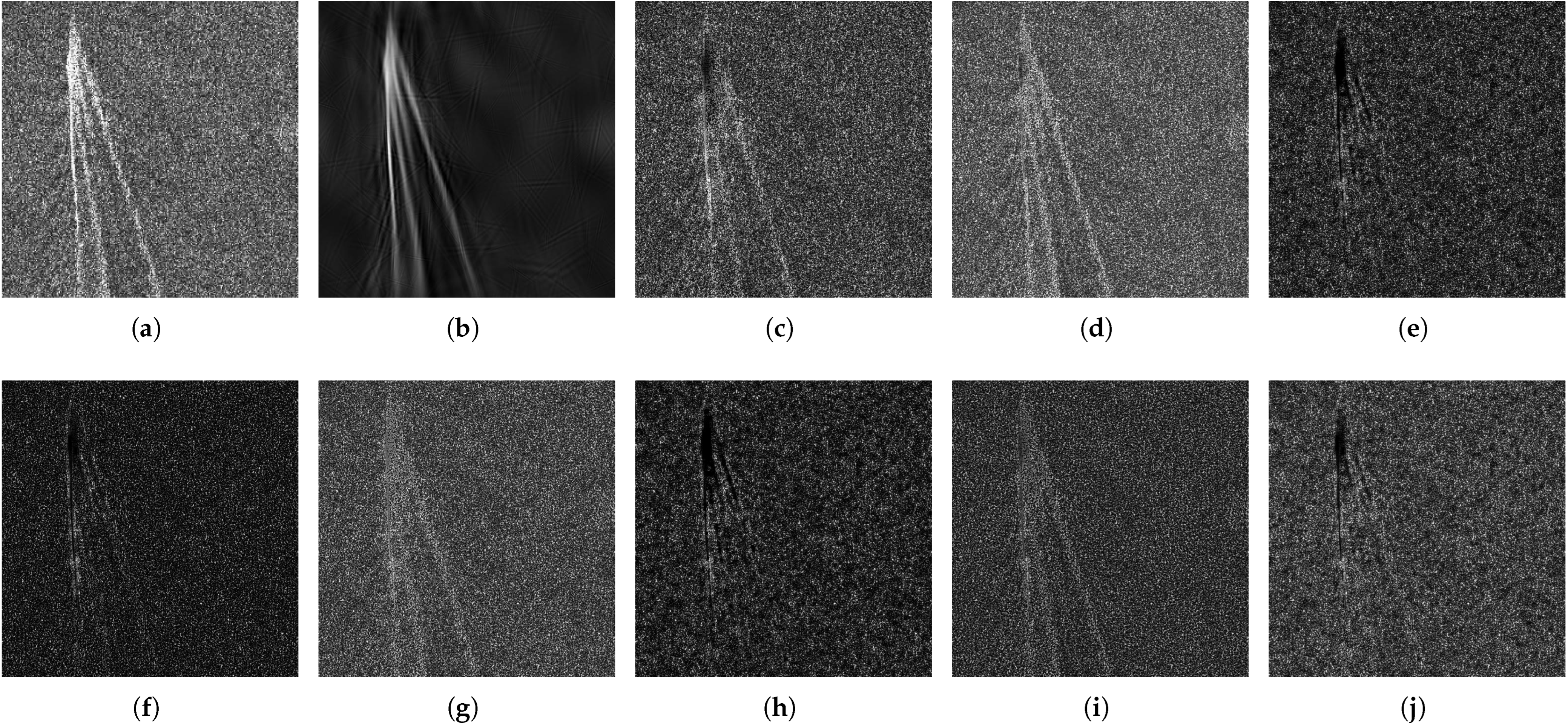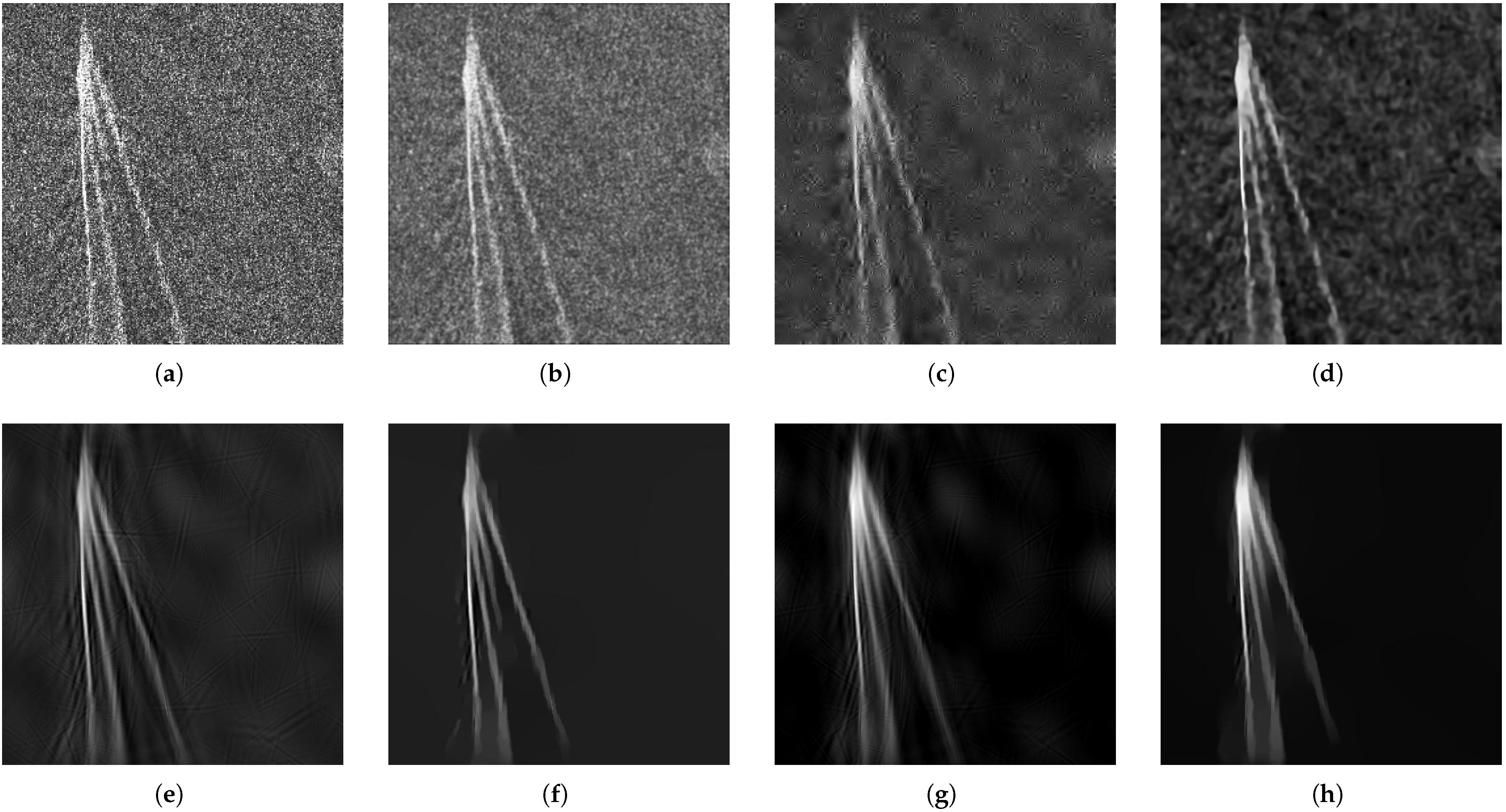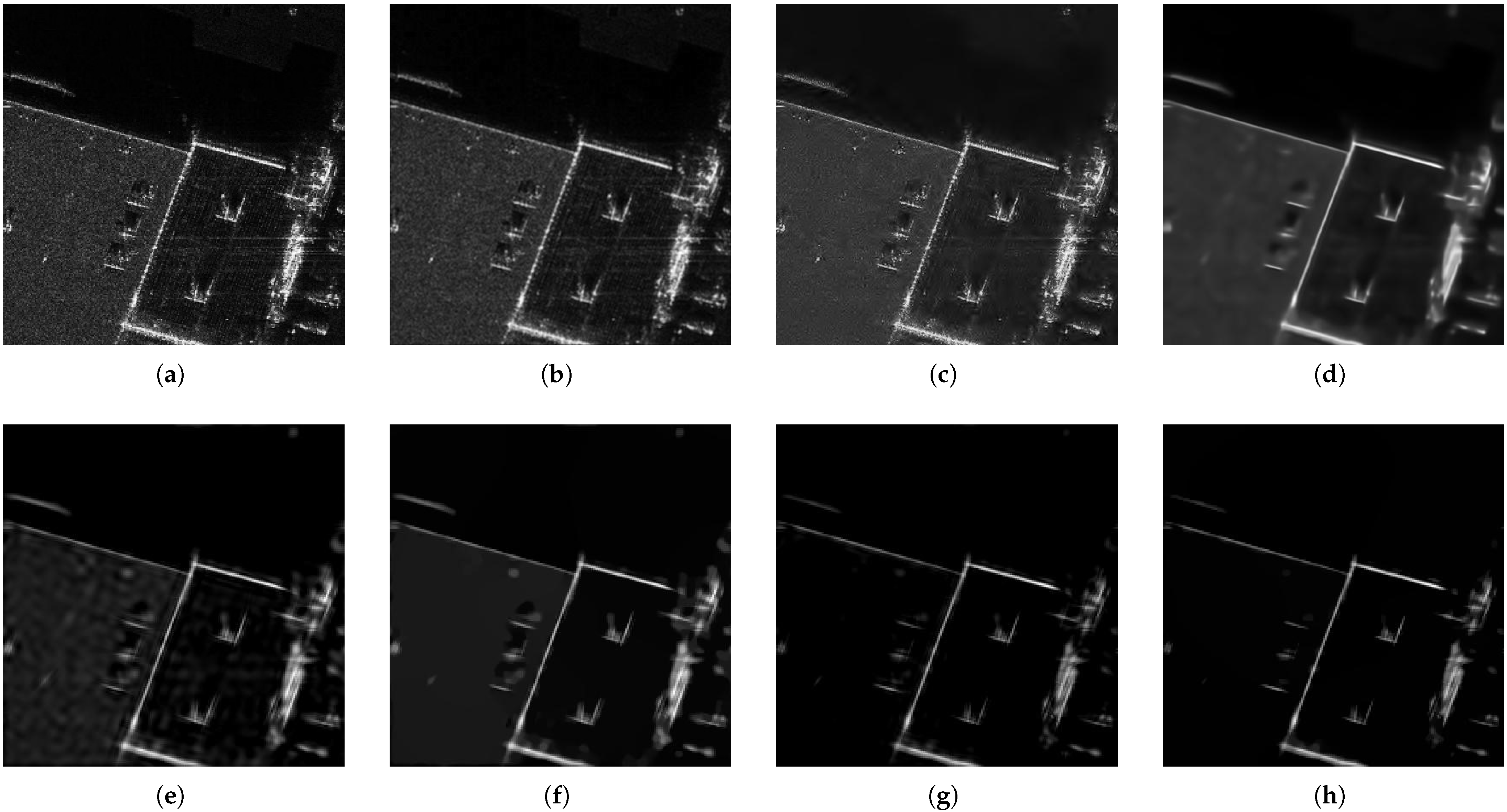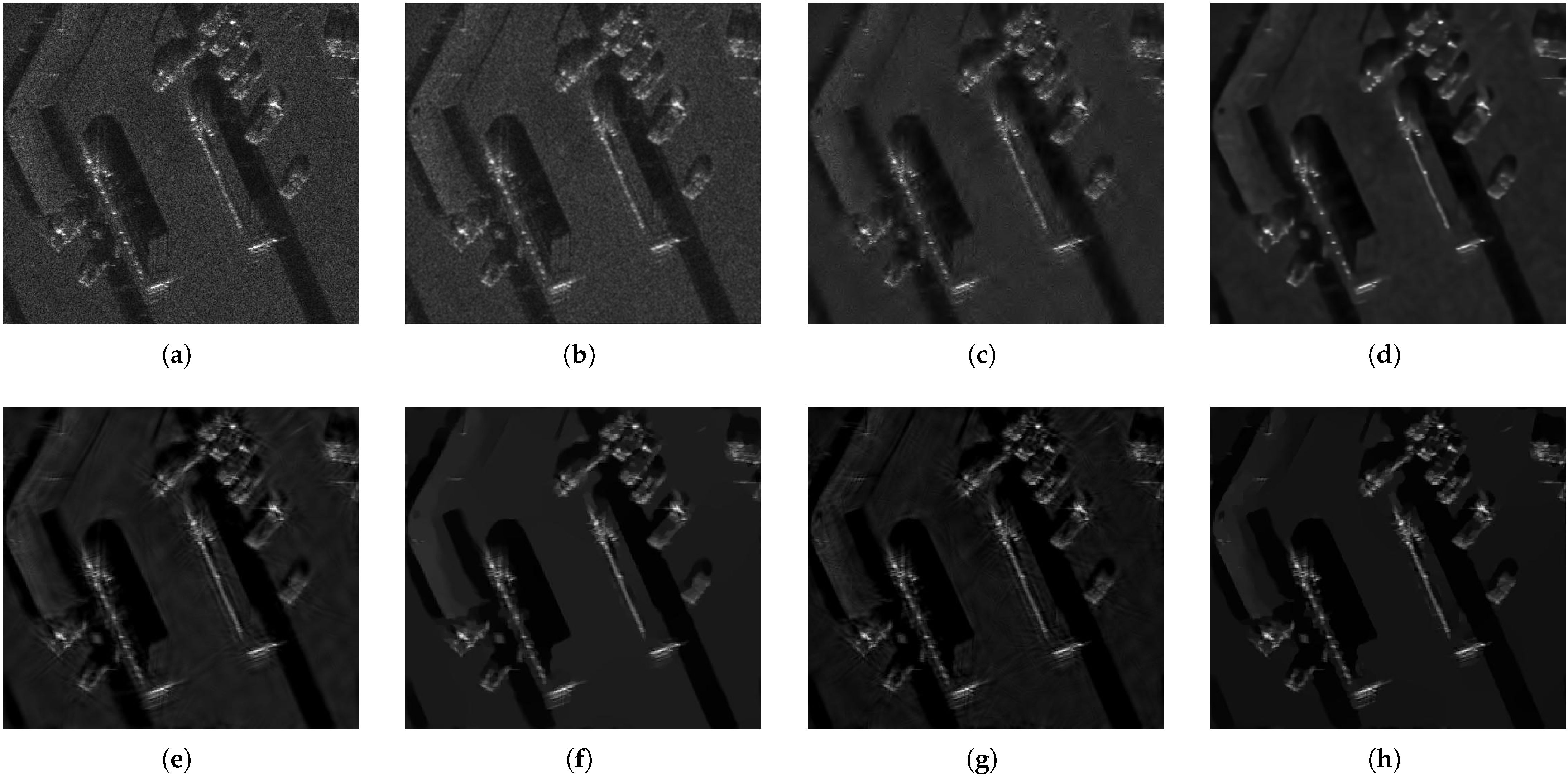Modified Morphological Component Analysis Method for SAR Image Clutter Suppression
Abstract
1. Introduction
2. Methodology
2.1. Existing MCA-Based SAR Image Clutter Suppression Method
2.2. Optimization Problem of the Proposed Method
2.2.1. Incoherence Constraint of Images
| Algorithm 1: The Incoherence Constraint Algorithm. |
|
2.2.2. Modified MCA Method
2.3. Solution to Optimization Problem
2.3.1. Updating Image Components
2.3.2. Gradient Minimization
| Algorithm 2: The Modified MCA Algorithm. |
|
3. Results
3.1. Experiments on Incoherence Constraint
3.2. Experiments of Modified MCA Method
3.2.1. Results with TSX Images
3.2.2. Results with FARAD Images
4. Discussion
5. Conclusions
Author Contributions
Funding
Data Availability Statement
Acknowledgments
Conflicts of Interest
Abbreviations
| SAR | synthetic aperture radar |
| MCA | morphological component analysis |
| DPCA | displaced phase center antenna |
| STAP | space-time adaptive processing |
| BM3D | block-matching and 3D-filtering |
| SVD | singular value decomposition |
| PCA | principal component analysis |
| CNN | convolutional neural network |
| GAN | generative adversarial network |
| GPR | ground-penetrating radar |
| UDWT | un-decimated discrete wavelet transform |
| ATR | automatic target recognition |
| BCD | block coordinate descent |
| TV | total variation |
| DCT | discrete cosine transform |
| MOD | method of optimal direction |
| K-SVD | K-singular value decomposition |
| ODL | online dictionary learning |
| TSX | TerraSAR-X |
| BSF | background suppression factor |
| SCR | Signal-to-clutter ratio |
References
- Song, Q.; Xu, F. Zero-Shot Learning of SAR Target Feature Space with Deep Generative Neural Networks. IEEE Geosci. Remote Sens. Lett. 2017, 14, 2245–2249. [Google Scholar] [CrossRef]
- Wang, B.; Song, C.; Liu, N.; Liu, Z.; Zhou, L.; Xiang, M. An Advanced Lightweight Dual-Band Digital Array SAR System: Earth Observation Imaging and Moving Target Detection. IEEE Sens. J. 2023, 23, 21776–21786. [Google Scholar] [CrossRef]
- Suwa, K.; Yamamoto, K.; Tsuchida, M.; Nakamura, S.; Wakayama, T.; Hara, T. Image-Based Target Detection and Radial Velocity Estimation Methods for Multichannel SAR-GMTI. IEEE Trans. Geosci. Remote Sens. 2017, 55, 1325–1338. [Google Scholar] [CrossRef]
- Yang, T.; Wang, Y.; Li, W. A Moving Target Imaging Algorithm for HRWS SAR/GMTI Systems. IEEE Trans. Aerosp. Electron. Syst. 2017, 53, 1147–1157. [Google Scholar] [CrossRef]
- Zhao, X.; Jiang, Y.; Wang, W.Q. Efficient Clutter Suppression in SAR Images with Shedding Irrelevant Patterns. IEEE Geosci. Remote Sens. Lett. 2015, 12, 1828–1832. [Google Scholar] [CrossRef]
- Lee, J.S. Digital Image Enhancement and Noise Filtering by Use of Local Statistics. IEEE Trans. Pattern Anal. Mach. Intell. 1980, PAMI-2, 165–168. [Google Scholar] [CrossRef]
- Frost, V.S.; Stiles, J.A.; Shanmugan, K.S.; Holtzman, J.C. A Model for Radar Images and Its Application to Adaptive Digital Filtering of Multiplicative Noise. IEEE Trans. Pattern Anal. Mach. Intell. 1982, PAMI-4, 157–166. [Google Scholar] [CrossRef]
- Acito, N.; Corsini, G.; Diani, M.; Pennucci, G. Comparative analysis of clutter removal techniques over experimental IR images. Opt. Eng. 2005, 44, 106401. [Google Scholar] [CrossRef]
- Sendur, L.; Selesnick, I. Bivariate shrinkage functions for wavelet-based denoising exploiting interscale dependency. IEEE Trans. Signal Process. 2002, 50, 2744–2756. [Google Scholar] [CrossRef]
- Dabov, K.; Foi, A.; Katkovnik, V.; Egiazarian, K. Image Denoising by Sparse 3-D Transform-Domain Collaborative Filtering. IEEE Trans. Image Process. 2007, 16, 2080–2095. [Google Scholar] [CrossRef]
- Abujarad, F.; Nadim, G.; Omar, A. Clutter reduction and detection of landmine objects in ground penetrating radar data using singular value decomposition (SVD). In Proceedings of the 3rd International Workshop on Advanced Ground Penetrating Radar, Delft, The Netherlands, 2–3 May 2005; IWAGPR 2005. pp. 37–42. [Google Scholar] [CrossRef]
- Lu, Q.Q.; Pu, J.X.; Wang, X.H.; Liu, Z.H. A clutter suppression algorithm for GPR data based on PCA combining with gradient magnitude. Appl. Mech. Mater. 2014, 644, 1662–1667. [Google Scholar] [CrossRef]
- Zhao, Y.; Yang, X.; Qu, X.; Lan, T.; Gong, J. Clutter Removal Method for GPR Based on Low-Rank and Sparse Decomposition With Total Variation Regularization. IEEE Geosci. Remote Sens. Lett. 2023, 20, 1–5. [Google Scholar] [CrossRef]
- Yan, H.; Chen, C.; Jin, G.; Zhang, J.; Wang, X.; Zhu, D. Implementation of a Modified Faster R-CNN for Target Detection Technology of Coastal Defense Radar. Remote Sens. 2021, 13, 1703. [Google Scholar] [CrossRef]
- Guo, J.; Lei, B.; Ding, C.; Zhang, Y. Synthetic Aperture Radar Image Synthesis by Using Generative Adversarial Nets. IEEE Geosci. Remote Sens. Lett. 2017, 14, 1111–1115. [Google Scholar] [CrossRef]
- Starck, J.L.; Elad, M.; Donoho, D. Image decomposition via the combination of sparse representations and a variational approach. IEEE Trans. Image Process. 2005, 14, 1570–1582. [Google Scholar] [CrossRef]
- Temlioglu, E.; Erer, I. Clutter Removal in Ground-Penetrating Radar Images Using Morphological Component Analysis. IEEE Geosci. Remote Sens. Lett. 2016, 13, 1802–1806. [Google Scholar] [CrossRef]
- Wagner, S. Morphological Component Analysis in SAR images to improve the generalization of ATR systems. In Proceedings of the 2015 3rd International Workshop on Compressed Sensing Theory and Its Applications to Radar, Sonar and Remote Sensing (CoSeRa), Pisa, Italy, 17–19 June 2015; pp. 46–50. [Google Scholar] [CrossRef]
- Yang, G.; Yu, J.; Xiao, C.; Sun, W. Ship wake detection for SAR images with complex backgrounds based on morphological dictionary learning. In Proceedings of the 2016 IEEE International Conference on Acoustics, Speech and Signal Processing (ICASSP), Shanghai, China, 20–25 March 2016; pp. 1896–1900. [Google Scholar] [CrossRef]
- Fadili, M.J.; Starck, J.L.; Bobin, J.; Moudden, Y. Image Decomposition and Separation Using Sparse Representations: An Overview. Proc. IEEE 2010, 98, 983–994. [Google Scholar] [CrossRef]
- Xu, L.; Lu, C.; Xu, Y.; Jia, J. Image smoothing via L0 gradient minimization. In Proceedings of the 2011 SIGGRAPH Asia Conference, Association for Computing Machinery, Hong Kong, China, 12–15 December 2011; Volume 30, pp. 1–12. [Google Scholar] [CrossRef]
- Starck, J.L.; Moudden, Y.; Bobin, J.; Elad, M.; Donoho, D.L. Morphological component analysis. In Wavelets XI. International Society for Optics and Photonics; SPIE: Bellingham, WA, USA, 2005; Volume 5914, p. 59140Q. [Google Scholar] [CrossRef]
- Kong, S.; Wang, D. A dictionary learning approach for classification: Separating the particularity and the commonality. In European Conference on Computer Vision; Springer: Berlin/Heidelberg, Germany, 2012; pp. 186–199. [Google Scholar] [CrossRef]
- Donoho, D.L.; Huo, X. Uncertainty principles and ideal atomic decomposition. IEEE Trans. Inf. Theory 2001, 47, 2845–2862. [Google Scholar] [CrossRef]
- Zhang, J. Gradient descent based optimization algorithms for deep learning models training. arXiv 2019, arXiv:1903.03614. [Google Scholar]
- Yuan, Q.; Zhang, L.; Shen, H. Multiframe Super-Resolution Employing a Spatially Weighted Total Variation Model. IEEE Trans. Circuits Syst. Video Technol. 2012, 22, 379–392. [Google Scholar] [CrossRef]
- Beck, A.; Teboulle, M. A fast iterative shrinkage-thresholding algorithm for linear inverse problems. SIAM J. Imaging Sci. 2009, 2, 183–202. [Google Scholar] [CrossRef]
- Bobin, J.; Starck, J.L.; Fadili, J.M.; Moudden, Y.; Donoho, D.L. Morphological Component Analysis: An Adaptive Thresholding Strategy. IEEE Trans. Image Process. 2007, 16, 2675–2681. [Google Scholar] [CrossRef]
- Daubechies, I. The wavelet transform, time-frequency localization and signal analysis. IEEE Trans. Inf. Theory 1990, 36, 961–1005. [Google Scholar] [CrossRef]
- Starck, J.L.; Candes, E.; Donoho, D. The curvelet transform for image denoising. IEEE Trans. Image Process. 2002, 11, 670–684. [Google Scholar] [CrossRef] [PubMed]
- Qayyum, A.; Malik, A.S.; Naufal, M.; Saad, M.; Mazher, M.; Abdullah, F.; Abdullah, T.A.R.B.T. Designing of overcomplete dictionaries based on DCT and DWT. In Proceedings of the 2015 IEEE Student Symposium in Biomedical Engineering and Sciences (ISSBES), Shah Alam, Malaysia, 4 November 2015; pp. 134–139. [Google Scholar] [CrossRef]
- Engan, K.; Aase, S.; Hakon Husoy, J. Method of optimal directions for frame design. In Proceedings of the 1999 IEEE International Conference on Acoustics, Speech, and Signal Processing, Proceedings, ICASSP99 (Cat. No.99CH36258), Phoenix, AZ, USA, 15–19 March 1999; Volume 5, pp. 2443–2446. [Google Scholar] [CrossRef]
- Aharon, M.; Elad, M.; Bruckstein, A. K-SVD: An algorithm for designing overcomplete dictionaries for sparse representation. IEEE Trans. Signal Process. 2006, 54, 4311–4322. [Google Scholar] [CrossRef]
- Mairal, J.; Bach, F.; Ponce, J.; Sapiro, G. Online dictionary learning for sparse coding. In Proceedings of the 26th Annual International Conference on Machine Learning, Association for Computing Machinery, Montreal, QC, Canada, 14–18 June 2009; pp. 689–696. [Google Scholar] [CrossRef]
- Deng, X.; Wang, Y.; He, D.; Han, G.; Xue, T.; Hao, Y.; Zhuang, X.; Liu, J.; Zhang, C.; Wang, S. A Compact Mid-Wave Infrared Imager System with Real-Time Target Detection and Tracking. IEEE J. Sel. Top. Appl. Earth Obs. Remote Sens. 2022, 15, 6069–6085. [Google Scholar] [CrossRef]
- Tang, H.; Lu, D.; Wang, L.; Gu, G. Infrared sea clutter suppression method based on gradient filtering. In AOPC 2022: Optical Sensing, Imaging, and Display Technology; Jiang, Y., Wang, X., Wang, Y., Liu, D., Xue, B., Eds.; International Society for Optics and Photonics; SPIE: Bellingham, WA, USA, 2023; Volume 12557, p. 125572B. [Google Scholar] [CrossRef]
- Chen, X.; Chen, W. Clutter reduction based on coefficient of variation in through-wall radar imaging. In Proceedings of the 2013 IEEE Radar Conference (RadarCon13), Ottawa, ON, Canada, 29 April–3 May 2013; pp. 1–4. [Google Scholar] [CrossRef]






| Methods | Sea Surface Scene | Coastal Scene | ||
|---|---|---|---|---|
| BSF | TCR (dB) | BSF | TCR (dB) | |
| Original image | 1.00 | 4.79 | 1.00 | 8.12 |
| Lee filter | 3.16 | 6.33 | 1.94 | 8.86 |
| Wavelet filter | 1.85 | 3.43 | 4.41 | 9.50 |
| BM3D filter | 4.24 | 10.89 | 4.06 | 15.87 |
| Conventional MCA | 11.95 | 12.44 | 4.45 | 22.11 |
| The MCA method with gradient minimization | 87.01 | 13.50 | 16.63 | 23.58 |
| The MCA method with incoherence constraint | 12.03 | 24.64 | 4.90 | 25.64 |
| The modified MCA method | 89.07 | 25.28 | 17.07 | 30.11 |
| Methods | FARAD Ka-Band Image | FARAD X-Band Image | ||
|---|---|---|---|---|
| BSF | TCR (dB) | BSF | TCR (dB) | |
| Original image | 1.00 | 8.55 | 1.00 | 5.24 |
| Lee filter | 2.21 | 8.24 | 1.55 | 6.01 |
| Wavelet filter | 1.58 | 4.61 | 2.14 | 6.15 |
| BM3D filter | 7.80 | 8.43 | 2.27 | 6.67 |
| Conventional MCA | 3.94 | 11.87 | 2.02 | 6.76 |
| The MCA method with gradient minimization | 56.43 | 12.75 | 2.59 | 7.02 |
| The MCA method with incoherence constraint | 8.81 | 27.30 | 2.33 | 10.20 |
| The modified MCA method | 66.40 | 33.98 | 2.78 | 10.52 |
| Methods | Sea Scene of TSX Image | Coastal Scene of TSX Image | FARAD Ka-Band Image | FARAD X-Band Image |
|---|---|---|---|---|
| Lee filter | 12.08 | 7.99 | 6.02 | 8.40 |
| Wavelet filter | 6.94 | 6.04 | 5.24 | 6.21 |
| BM3D filter | 60.19 | 38.11 | 32.65 | 46.31 |
| Conventional MCA | 309.53 | 200.61 | 143.96 | 221.45 |
| The MCA method with gradient minimization | 321.10 | 203.59 | 149.26 | 226.69 |
| The MCA method with incoherence constraint | 323.27 | 204.98 | 151.11 | 228.22 |
| The modified MCA method | 332.43 | 210.35 | 156.57 | 235.69 |
Disclaimer/Publisher’s Note: The statements, opinions and data contained in all publications are solely those of the individual author(s) and contributor(s) and not of MDPI and/or the editor(s). MDPI and/or the editor(s) disclaim responsibility for any injury to people or property resulting from any ideas, methods, instructions or products referred to in the content. |
© 2025 by the authors. Licensee MDPI, Basel, Switzerland. This article is an open access article distributed under the terms and conditions of the Creative Commons Attribution (CC BY) license (https://creativecommons.org/licenses/by/4.0/).
Share and Cite
Xiao, S.; Xu, H.; Sun, B.; Liu, W. Modified Morphological Component Analysis Method for SAR Image Clutter Suppression. Remote Sens. 2025, 17, 1727. https://doi.org/10.3390/rs17101727
Xiao S, Xu H, Sun B, Liu W. Modified Morphological Component Analysis Method for SAR Image Clutter Suppression. Remote Sensing. 2025; 17(10):1727. https://doi.org/10.3390/rs17101727
Chicago/Turabian StyleXiao, Shuangying, Huaping Xu, Bing Sun, and Wei Liu. 2025. "Modified Morphological Component Analysis Method for SAR Image Clutter Suppression" Remote Sensing 17, no. 10: 1727. https://doi.org/10.3390/rs17101727
APA StyleXiao, S., Xu, H., Sun, B., & Liu, W. (2025). Modified Morphological Component Analysis Method for SAR Image Clutter Suppression. Remote Sensing, 17(10), 1727. https://doi.org/10.3390/rs17101727








